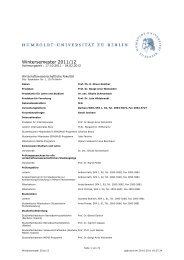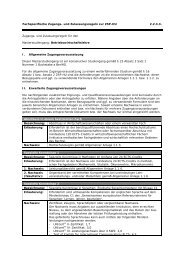Measuring the Effects of a Shock to Monetary Policy - Humboldt ...
Measuring the Effects of a Shock to Monetary Policy - Humboldt ...
Measuring the Effects of a Shock to Monetary Policy - Humboldt ...
You also want an ePaper? Increase the reach of your titles
YUMPU automatically turns print PDFs into web optimized ePapers that Google loves.
50 Bayesian FAVARs with Agnostic Identification<br />
presented serve <strong>the</strong> indication that, for <strong>the</strong> researcher interested in measuring <strong>the</strong> effects<br />
<strong>of</strong> a shock <strong>to</strong> monetary policy, it is crucial <strong>to</strong> apply identifying restrictions that are<br />
consistent with <strong>the</strong> conventional wisdom, such as <strong>the</strong> agnostic identification using sign<br />
restrictions. When comparing <strong>the</strong> results from <strong>the</strong> Gibbs sampling approach and com-<br />
pare <strong>the</strong>m with <strong>the</strong> ones provided by BBE it is quite evident that <strong>the</strong> results seem more<br />
reasonable especially w.r.t. <strong>the</strong> quantitative measure and <strong>the</strong> certainty with with <strong>the</strong><br />
results are reported. They do not show <strong>the</strong> great uncertainty as <strong>the</strong> results generated eith<br />
standard identification. The results are even more accurate some variables compared <strong>to</strong><br />
<strong>the</strong> principal componant approach. Such variables are e.g. <strong>the</strong> commodity price index<br />
and <strong>the</strong> capacity utilization rate. However one should be cautious and still try out draws<br />
<strong>of</strong> at least 10000 in order <strong>to</strong> be conclusively certain with respect <strong>to</strong> <strong>the</strong> accuracy <strong>of</strong> <strong>the</strong><br />
results. Although I have tried out many versions and several runs producing very similar<br />
results I think <strong>the</strong> results will still have <strong>to</strong> be confirmed with an iteration <strong>of</strong> say 10000<br />
draws <strong>to</strong> be completely sure. This was not feasible due <strong>to</strong> severe time constraints and <strong>the</strong><br />
lack <strong>of</strong> time an appropriate (fast) computer that has no memory problems. It is advisable<br />
<strong>to</strong> use an unix based system.<br />
The most interesting suggestion <strong>to</strong> me seem <strong>to</strong> be even more strict with <strong>the</strong> restriction<br />
in that sense that one should set <strong>the</strong> restrictions for many prices, money aggregates <strong>the</strong><br />
some short term interest rates. This could be accomplished only partly as <strong>the</strong> acceptance<br />
<strong>of</strong> ”reasonable” impulse responses decreases sharply. Hence one should be patient whiöe<br />
waiting for <strong>the</strong> results. Fur<strong>the</strong>r extensions w.r.t. <strong>the</strong> model could be <strong>to</strong> model time vary-<br />
ing fac<strong>to</strong>r loadings and s<strong>to</strong>chastic volatility e.g.in order <strong>to</strong> analyze <strong>the</strong> change <strong>of</strong> monetary<br />
policy in a ”data-rich environment” over time 36 As a next step one could also start <strong>to</strong><br />
identify fur<strong>the</strong>r shocks and measure <strong>the</strong> respective effects like <strong>the</strong> one <strong>to</strong> fiscal policy in<br />
a FAVAR framework, as it has been done by Mountford and Uhlig [2004] in <strong>the</strong> VAR<br />
framework.<br />
36 See Cogley and Sargent [2003].



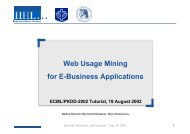
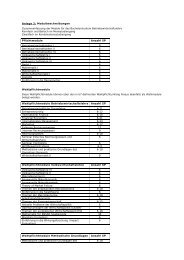
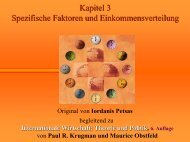
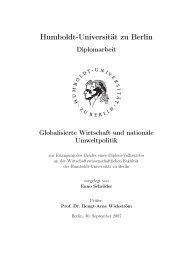
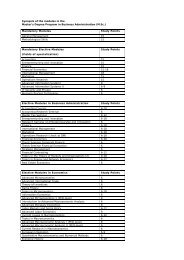
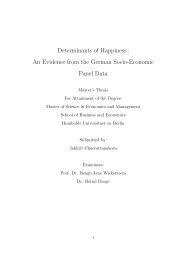
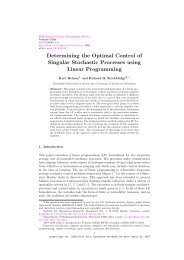
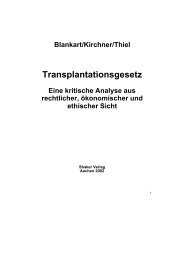
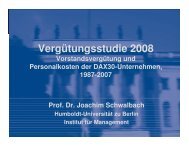

![[Text eingeben] [Text eingeben] Lebenslauf Anna-Maria Schneider](https://img.yumpu.com/16300391/1/184x260/text-eingeben-text-eingeben-lebenslauf-anna-maria-schneider.jpg?quality=85)

